Before this, the author has shared many of the latest performance tests of classic old processors, from the third-generation Core to the tenth-generation Core, including Core i7-3770, Core i5-4570, Core i7-4790, Core i7-6700, Core i5-8400, Core i7-8700, Core i5-9400F, and Core i3-10100F, etc.
If the memory and graphics card are reasonably matched, these old processors can still be used for daily office work and light entertainment without any problems. Under 1080P resolution, apart from some heavyweight games, most mainstream games can run smoothly.
However, there is a very significant drawback: CPU usage is very high, generally above 70%, or even above 90%, making it quite strenuous overall. This is hard to accept for many friends with OCD, and can only be said to be usable with compromises.
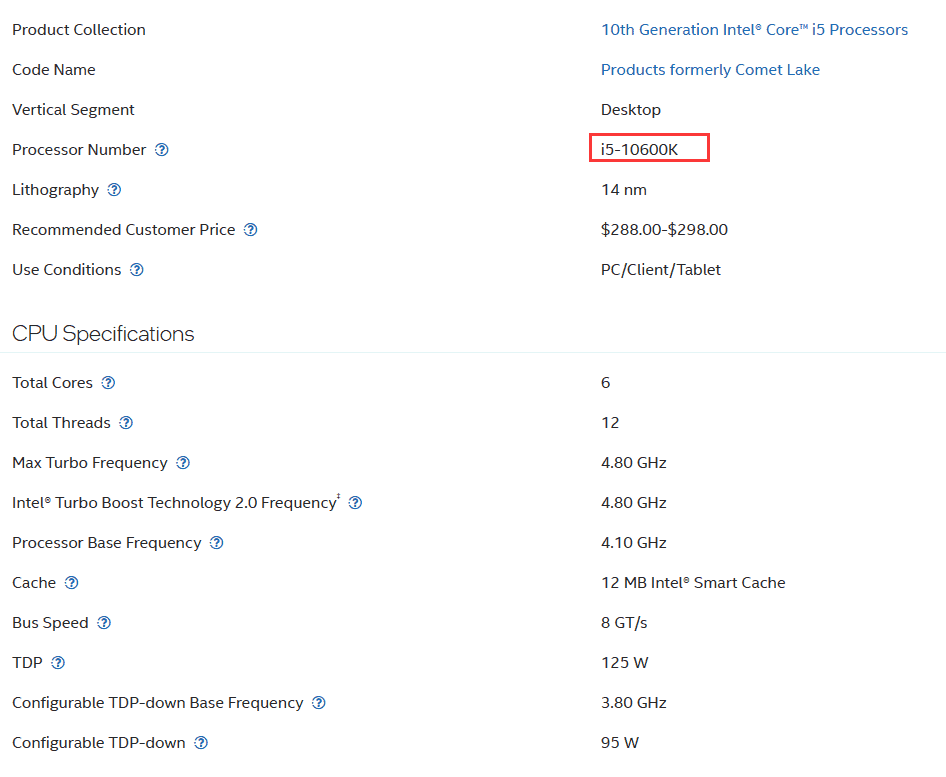
The author will now share the latest performance tests of the tenth-generation i5 Core i5-10600K. Compared to the Core i3-10100F, it is much stronger in all aspects: more cores and threads, higher operating frequency, larger cache capacity, approximately 13% better single-core performance, and 65% better multi-core performance.
So, in the final gaming performance tests, how does the Core i5-10600K perform? Can its performance be used now? Is an upgrade necessary? This article will reveal the answers for everyone’s reference.
01
Parameter Review of i5-10600K
The Core i5-10600K was released on April 30, 2020, using a 14-nanometer process, featuring 6 cores and 12 threads, with a base operating frequency of 4.1GHz, a maximum operating frequency of 4.8GHz, equipped with 12MB of smart cache, power consumption of 125W, and a suggested retail price of 288.00-298.00 US dollars.
02
Benchmark Performance Comparison of i5-10600K

Before officially entering the gaming test phase, let’s take a look at the score comparison between the Core i5-10600K and the latest Core i5-14600K to see how big the difference is.
In the Cinebench R23 platform, the Core i5-10600K scored 1391 points in single-core performance and 10489 points in multi-core performance, while the Core i5-14600K scored 2097 points in single-core performance and 24683 points in multi-core performance.
Calculating from this data, the Core i5-14600K’s single-core performance and multi-core performance are approximately 1.5 times and 2.4 times respectively that of the Core i5-10600K.
03
Test Platform Configuration on i5-10600K
The main configurations are as follows:
- Processor: Core i5-10600K
- Memory: 32GB DDR4
- Graphics Card: GeForce GTX 1080 Ti
- Operating System: Windows 11
04
Gaming Tests of i5-10600K
The following seven games will be individually tested, all using 1080P at the highest quality settings. This setup ensures the smooth running of mainstream games without any issues. However, the primary focus is to examine the specific performance of the Core i5-10600K.
① The First Game is ‘Dead Space’
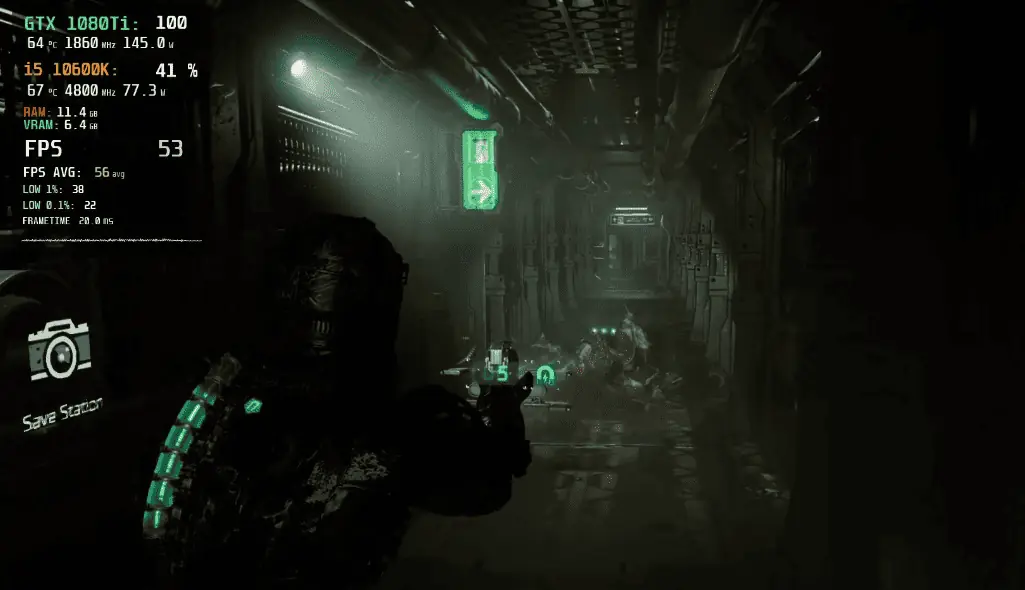
- Average Frame Rate: 56 FPS
- Lowest Instantaneous Frame Rate: 38 FPS
- Frame Time: 20.0ms
- CPU usage: 41%
- Power Consumption: 77.3W
- CPU Temperature: 67 degrees
- Memory usage: 11.4GB
- GPU usage: 100%
- Video Memory usage: 6.4GB
- Power Consumption: 145W
- GPU Temperature: 64 degrees
In this game, the CPU usage is only about 40%, quite relaxed, memory usage exceeds 11GB, GPU usage is 100%, completely maxed out, there is no issue of being unable to handle GeForce GTX 1080 Ti, the graphics card performance is maxed out, and the video memory usage exceeds 6GB.
In terms of average frame rate, it can reach above 50 FPS, and the lowest instantaneous frame rate is also above 30 FPS, with a frame time of 20.0ms, and slightly higher latency. The graphics card’s performance is somewhat insufficient, and a bit strenuous, but overall performance is still acceptable.
② The Second Game is ‘Fortnite’

- Average Frame Rate: 101 FPS
- Lowest Instantaneous Frame Rate: 72 FPS
- Frame Time: 13.5ms
- CPU usage: 40%
- Power Consumption: 68.4W
- CPU Temperature: 61 degrees
- Memory usage: 14.0GB
- GPU usage: 97%
- Video Memory usage: 4.6GB
- Power Consumption: 176W
- GPU Temperature: 67 degrees
In this game, the CPU usage is also around 40%, memory usage reaches 14GB, quite memory-intensive, GPU usage is 97%, nearing full load, and video memory usage is less than 5GB.
Regarding the average frame rate, it can reach around 100 FPS, with the lowest instantaneous frame rate above 70 FPS, and a frame time of around 13ms, overall performance is excellent, without any apparent shortcomings.
③ The Third Game is ‘Cyberpunk 2077’

- Average Frame Rate: 62 FPS
- Lowest Instantaneous Frame Rate: 45 FPS
- Frame Time: 20.4ms
- CPU usage: 67%
- Power Consumption: 92.4W
- CPU Temperature: 71 degrees
- Memory usage: 10.9GB
- GPU usage: 93%
- Video Memory usage: 5.7GB
- Power Consumption: 183W
- GPU Temperature: 68 degrees
In this game, the CPU usage reaches 67%, nearly two-thirds, indicating a relatively high usage rate; memory usage is around 11GB, GPU usage is only 93%, and video memory usage is less than 6GB.
Regarding the average frame rate, it can achieve around 60 FPS, with the lowest instantaneous frame rate above 40 FPS, frame time around 20ms, slightly higher, but overall performance is acceptable.
④ The Fourth Game is ‘The Finals’
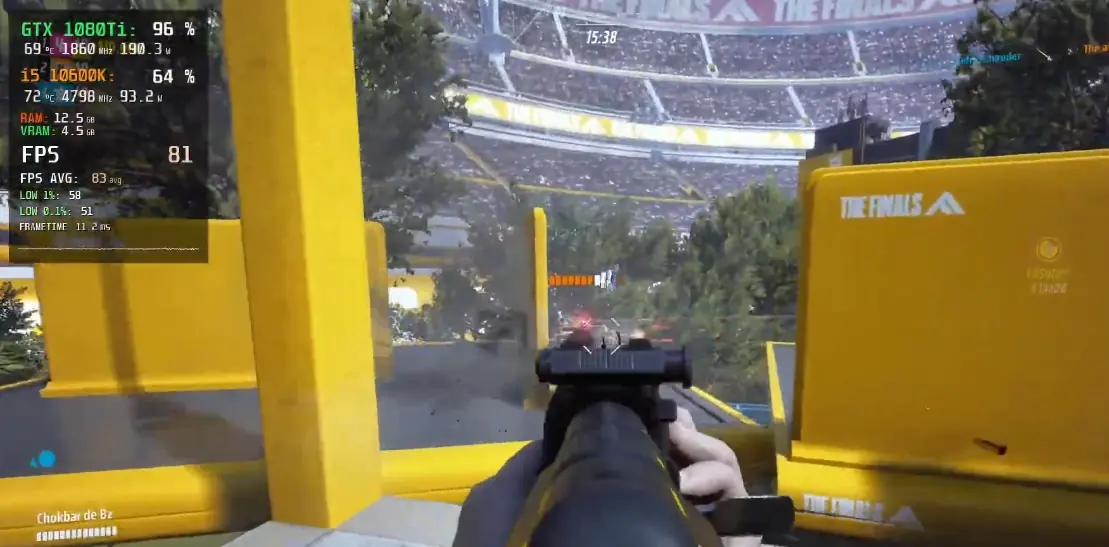
- Average Frame Rate: 83 FPS
- Lowest Instantaneous Frame Rate: 58 FPS
- Frame Time: 11.2ms
- CPU usage: 64%
- Power Consumption: 93.2W
- CPU Temperature: 72 degrees
- Memory usage: 12.5GB
- GPU usage: 96%
- Video Memory usage: 4.5GB
- Power Consumption: 190W
- GPU Temperature: 69 degrees
In this game, CPU usage exceeds 60%, memory usage goes beyond 12GB, GPU usage is 96%, and video memory usage is less than 5GB, indicating some idle capacity in the graphics card performance.
Regarding the average frame rate, it can reach above 80 FPS, with the lowest instantaneous frame rate also above 50 FPS, frame time of 11ms. Overall performance is excellent, without any apparent shortcomings.
⑤ The Fifth Game is ‘Ghostwire: Tokyo’
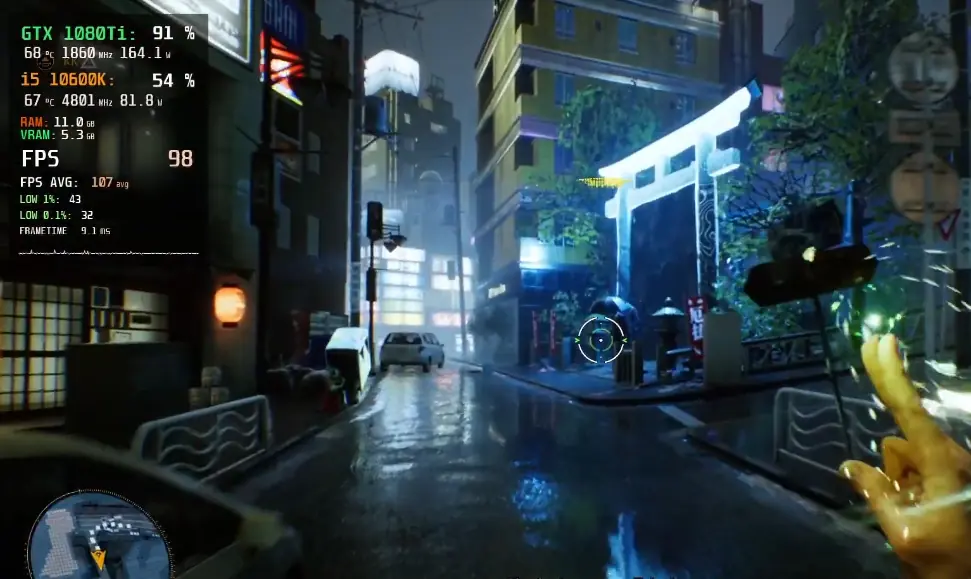
- Average Frame Rate: 107 FPS
- Lowest Instantaneous Frame Rate: 43 FPS
- Frame Time: 9.1ms
- CPU usage: 54%
- Power Consumption: 81.8W
- CPU Temperature: 67 degrees
- Memory usage: 11.0GB
- GPU usage: 91%
- Video Memory usage: 5.3GB
- Power Consumption: 164W
- GPU Temperature: 68 degrees
In this game, CPU usage exceeds 50%, memory usage is around 11GB, GPU usage is 91%, and video memory usage is just over 5GB, suggesting some spare capacity in the graphics card performance.
Regarding the average frame rate, it can achieve above 100 FPS, with the lowest instantaneous frame rate above 40 FPS, a frame time of around 9ms. It runs smoothly and steadily without any noticeable weaknesses.
⑥ The Sixth Game is ‘Starry Sky’
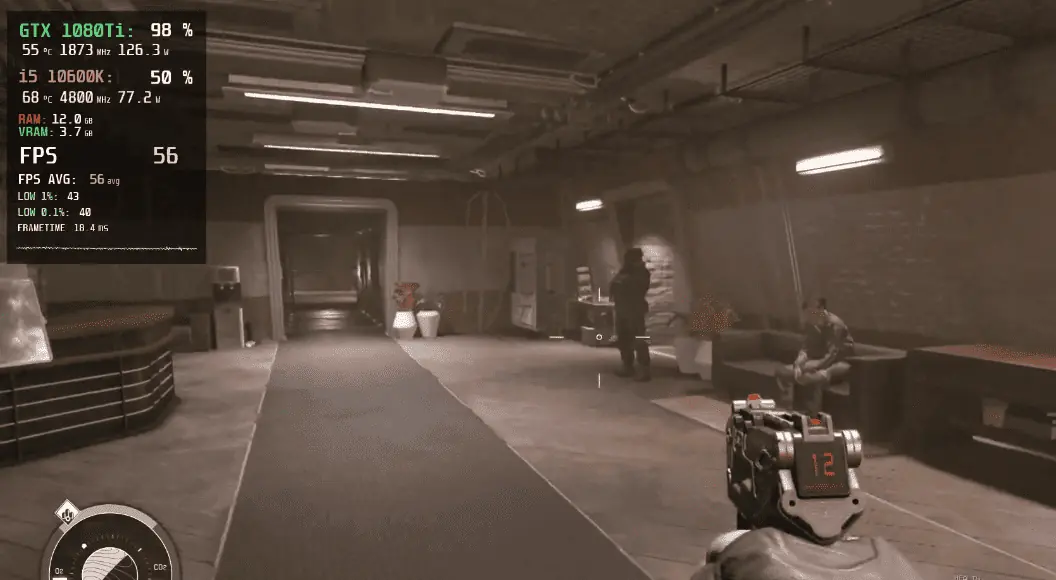
- Average Frame Rate: 56 FPS
- Lowest Instantaneous Frame Rate: 43 FPS
- Frame Time: 18.4ms
- CPU usage: 50%
- Power Consumption: 77.2W
- CPU Temperature: 68 degrees
- Memory usage: 12.0GB
- GPU usage: 98%
- Video Memory usage: 3.7GB
- Power Consumption: 126W
- GPU Temperature: 55 degrees
In this game, CPU usage is around 50%, memory usage is around 12GB, GPU usage is 98%, nearing full load, and video memory usage is less than 4GB.
Regarding the average frame rate, it can achieve above 50 FPS, with the lowest instantaneous frame rate above 40 FPS, and frame time below 20ms. Overall, it runs smoothly without any issues, demonstrating stable performance.
⑦ The Seventh Game is ‘The Legacy of Hogwarts’
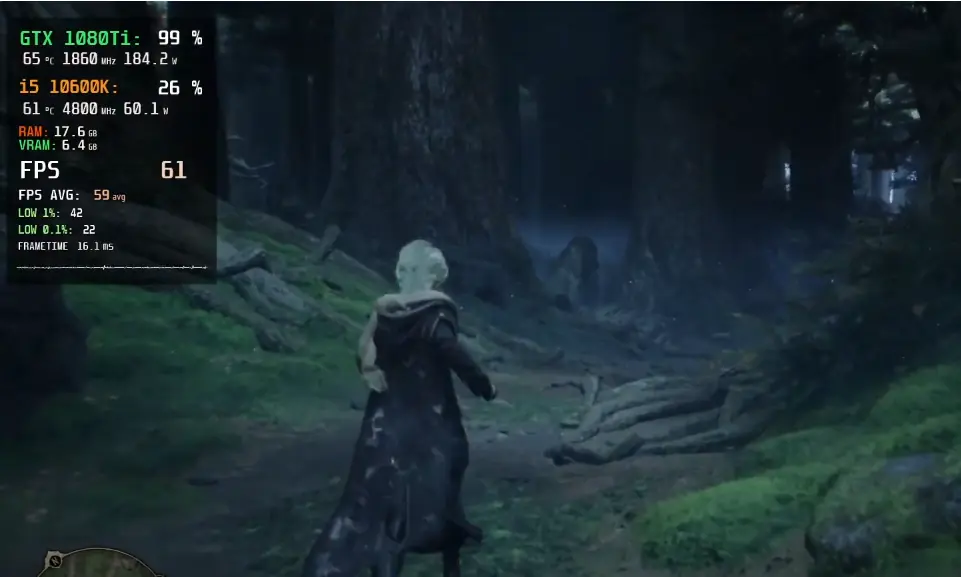
- Average Frame Rate: 59 FPS
- Lowest Instantaneous Frame Rate: 42 FPS
- Frame Time: 16.1ms
- CPU usage: 26%
- Power Consumption: 60.1W
- CPU Temperature: 61 degrees
- Memory usage: 17.7GB
- GPU usage: 99%
- Video Memory usage: 6.4GB
- Power Consumption: 184W
- GPU Temperature: 65 degrees
In this game, CPU usage is below 30%, nearly a quarter, but memory usage approaches 18GB, quite memory-intensive. GPU usage is almost at full load, with video memory usage exceeding 6GB, indicating heavy memory and graphics card resource consumption overall.
Regarding the average frame rate, it can maintain above 50 FPS, with the lowest instantaneous frame rate above 40 FPS, and frame time around 16ms, running smoothly without issues.
05
Conclusion of Test on i5-10600K
The results are quite evident that the Core i5-10600K performs significantly better than the older processors tested previously. Throughout the testing, the CPU usage never exceeded 70%, generally staying between 40% and 60%, which indicates a relatively relaxed performance. If coupled with a higher-tier graphics card, it’s expected that the gaming performance would further improve.
From the current situation, it appears that only processors at or above the level of the 10th Gen Core i5-10600K can provide a relatively comfortable user experience without performance concerns. If you are currently using the Core i5-10600K and your requirements are not exceptionally demanding, there might not be a necessity for an upgrade.




